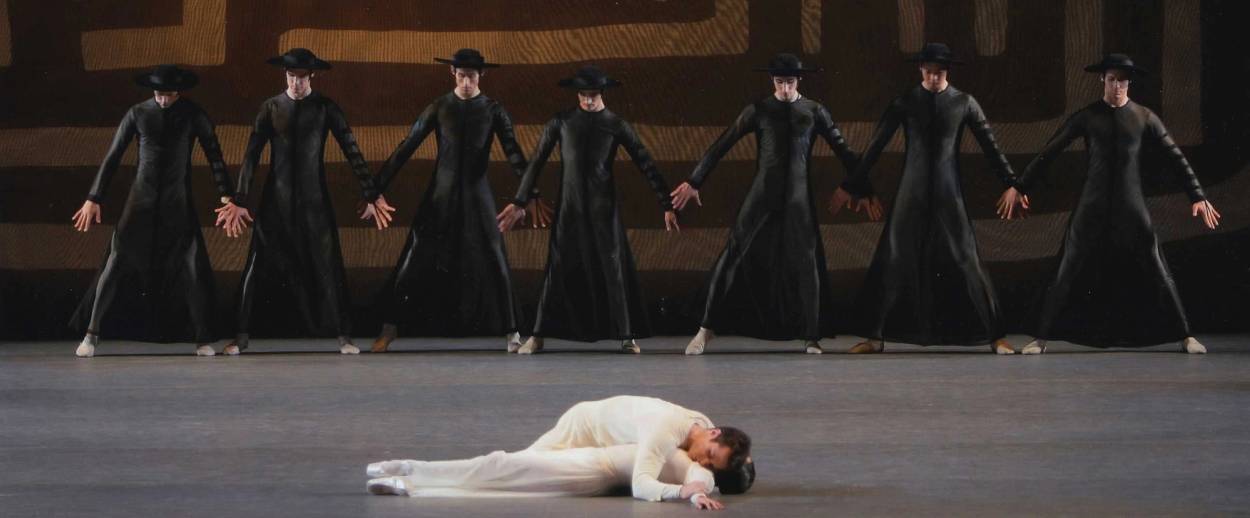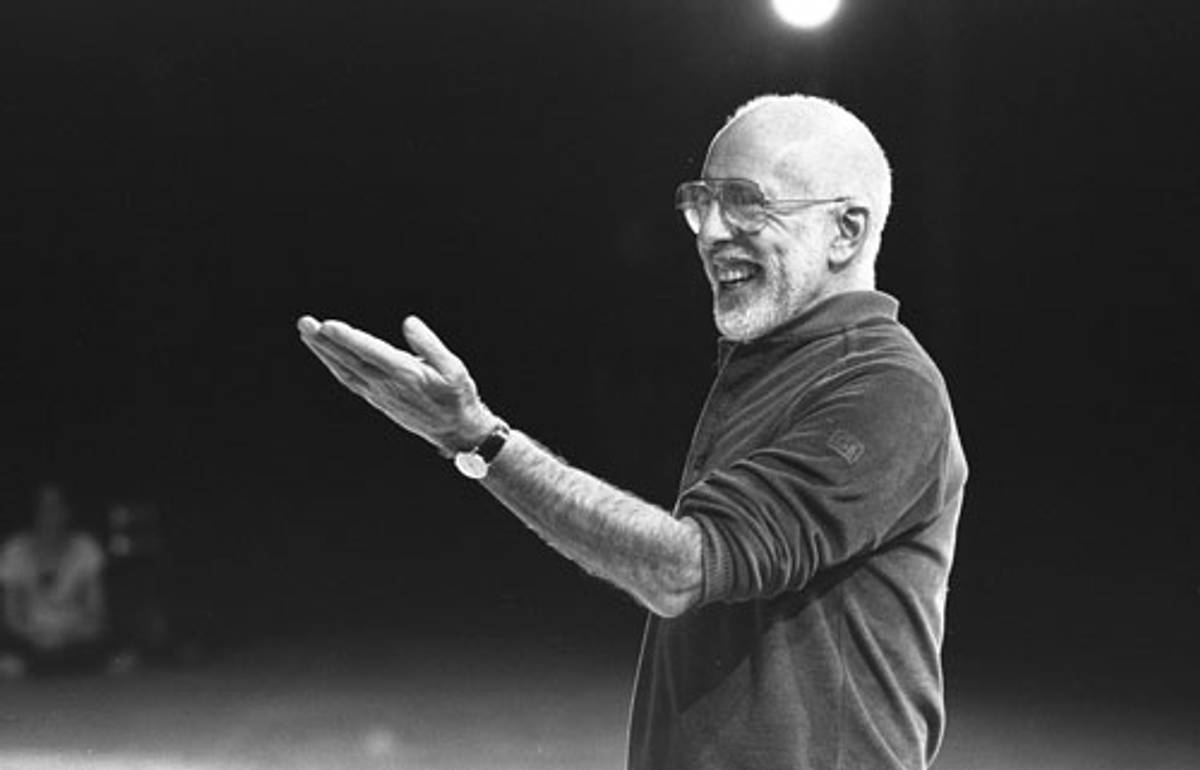Leonard Bernstein and Jerome Robbins’ ‘Dybbuk’ Returns
It’s the opposite of ‘Fiddler on the Roof.’ New York City Ballet’s new production opens this week.




Between 1913 and 1916, Shloyme Zaynvl Rapoport, known as S. Ansky, penned a play called The Dybbuk: Between Two Worlds that revolutionized Yiddish theater. First performed in Warsaw in 1920, the play depicts the love of Chanon and Leah, promised to each other at birth but thwarted when Leah’s father backtracks on that pledge and gives her to another man. Chanon dies of a broken heart, then returns as a dybbuk, a wandering soul who possesses bodies, in this case, Leah’s. She rejects her new suitor, exorcises Chanon, and then she, too, dies. The Dybbuk was a big hit.
Across the ocean in 1940s America, the story caught the attention of two young Jewish wunderkinds: choreographer Jerome Robbins and composer Leonard Bernstein, both 26, who had just scored a major success with their first ballet collaboration, Fancy Free, about the antics of three sailors on leave in New York City (it was the seed of the Broadway musical On the Town). Fancy Free was the start of a creative partnership, and contentious friendship, that would last their entire lives and produce masterpieces like West Side Story before finally circling back, in 1974, to Ansky’s tale.
This spring as part of New York City Ballet’s Robbins 100 Festival, marking the centenary of the dancemaker’s birth, the company is reviving Dybbuk at Lincoln Center for the first time in more than a decade (through May 20). If Fiddler on the Roof, which Robbins directed and choreographed in 1964, was interpreted as an abstract classical ballet, it might look a bit like Dybbuk.
“S. Ansky’s play is built on elements Robbins was drawn to: religious mysticism, sense of community, powerful drama, and an Eastern European Jewish ambience,” wrote Deborah Jowitt in her 2004 biography of Robbins. But unlike in Fiddler, which was filled with warmth, humor and robust characters, Dybbuk the ballet takes a non-narrative, episodic approach to evoking personal and communal tensions. It trades Fiddler’s colorful Chagall-esque whimsy for stripped-down, black-and-white shtetl minimalism and swaps Jerry Bock’s lively, melodic tunes for Bernstein’s haunting, discordant score. You might say Dybbuk is Fiddler assimilated as high art.
Owing to its source material, themes, the heritage of its creators, and the fact that it begins with the chanting of Hebrew prayers, Dybbuk is arguably the most Jewish ballet ever made in America, or likely anywhere. But Robbins in particular had a complicated and evolving relationship with his Jewish identity. In many ways, Dybbuk is an apt illustration of that tension. “I didn’t want to be a Jew,” he wrote in notes for a planned autobiography. “I wanted to be safe, protected, assimilated, hidden in among the Goys, the majority.”
After playing around with various stage names and spellings, 19-year-old Jerome Wilson Rabinowitz settled on Jerome Robbins in 1937. Ironically, it was for a production of The Brothers Ashkenazi at the Yiddish Art Theatre that Robbins symbolically distanced himself from his Jewish heritage, as many performers did at the time. (After his success in the 1940s, Robbins’ parents changed their surname to match his.) “Convert convert!” he admonished himself in his autobiographical notes. “No, don’t adopt the Christian religion—do not go that far; but leave behind forever the Jew part. I became Jerry Robbins.”
Following the triumphs of Fancy Free and On the Town, Robbins would go on to direct and/or choreograph some of the most celebrated musicals of the 20th century, including The King and I, Gypsy, and West Side Story (he shared an Oscar for co-directing the film), as well as Fiddler, which helped him embrace the Jewish roots he had rejected in his youth. In the process, writes Alisa Soloman in her book Wonder of Wonders: A Cultural History of Fiddler on the Roof, Robbins “staged his own passage from Jewish repudiation to conciliatory embrace.” (He would visit Israel often in the 1950s and become closely associated with the America-Israel Cultural Foundation.)

But despite conquering Broadway and Hollywood, Robbins considered ballet a higher form of expression and also recognized it as a means to distance himself from his own culture by speaking through the “language of court & Christianity,” as he called it. He revered George Balanchine, the legendary Russian co-founder of City Ballet, and sought to emulate Balanchine’s stark, neo-classical works. In 1969, Robbins mostly turned away from theater to concentrate on classical ballet, creating enduring works like Dances at a Gathering and Glass Pieces.
Dybbuk was Robbins’ attempt to reconcile his inherited culture and his idealized art. Rather than tell a Jewish story in the populist vernacular of the musical, he wanted to do so in the refined physical language of ballet. The idea percolated between Robbins and Bernstein for 30 years, first mentioned in 1944 and popping up intermittently, as when Robbins sent Bernstein a note in 1958 that began, “Dybbuk Dybbuk Dybbuk” in an effort to nudge Bernstein into writing the score.
‘Dybbuk’ is arguably the most Jewish ballet ever made in America.
Finally, in 1972, the artists, both firmly established American legends at that point, began to focus more seriously on the project. They escaped to Jamaica, Jowitt reported, and “tried to thrash out a structure. They smoked ganja and shared childhood memories.” Long-held resentments boiled to the surface: Bernstein admitted he was scared of Robbins while Robbins felt Bernstein was “always putting me down.” (In addition to sharing religion and success, the two men shared an uneasy acceptance of their sexuality—both had relationships with men and women.)
A structure of Dybbuk was settled on by 1974, albeit a shaky and shifting one. When Robbins finally began working with his dancers, he did something rare: He gave them Ansky’s play. “I was taken by surprise that he did that,” recalls Helgi Tómasson, Dybbuk’s original Chanon and now artistic director of the San Francisco Ballet. “He wanted us to have an understanding of the story, which was rather unusual for him.”
Robbins’ excitement in the studio was palpable: “There were times I felt he was working very hard at getting to say what he wanted to say in this complicated story,” says Tómasson. The resulting movement alternates between aggressive precision and exultant fluidity, evoking the rigidity of community at odds with individual desires. Some of its imagery nods very subtly to Jewish folk dances, but Robbins mostly sticks to classical ballet vocabulary—as if the Bottle Dancers in Fiddler’s wedding scene had trained at the Bolshoi. In the ethereal duets between the lovers, you can practically see Chagall’s painted newlyweds in flight, albeit stripped of color.
Bernstein, for his part, composed a breathtaking score that he said was inspired by the dualisms in Ansky’s play. He described the work’s first suite as having “a consistent ethnic quality, a ‘Jewish’ sound,” while the second was more “Kabalistic … and far less ethnic in character.” Bernstein’s biographer Humphrey Burton called the ballet score “the purest statement [Bernstein] made of his specifically Ukraine-Jewish heritage.”
Dybbuk premiered on May 16, 1974 to mixed reviews (“the loving handiwork of inspired men,” said one; “all windup, no delivery,” said another), which stung the always-sensitive Robbins, especially for such a personal work. His attempt to convey the beauty and mystery of his faith through conceptual classical dance hadn’t satisfied those who had come to expect lucid, vibrant storytelling from him, or perhaps they were inevitably comparing it with the overt theatricality of Fiddler.
“I think Lenny and I had different ideas,” Robbins later admitted of the different ways he and Bernstein approached the material. “He took the dramatic side. I took the abstract. They’re two parallel paths that don’t converge.” And almost immediately after its lukewarm reception, Robbins began chipping away at the work, introducing another version later that year called The Dybbuk Variations. By 1980, he had distilled it even further to Suite of Dances—no longer even associated by name with its mystical Yiddish source. He was later encouraged to revive the complete ballet. “It was a mistake to diminish it into Variations,” City Ballet’s co-founder Lincoln Kirstein told him in 1986. But Robbins had moved on. “As you know, I was never satisfied,” he replied.
In 2005, several years after Robbins’ death in 1998, Tómasson revived the work in its original form for San Francisco Ballet. “I loved dancing that ballet,” Tómasson says. “It was fulfilling.” City Ballet brought the full version briefly back to its repertory in 2007 and now again this season.
Perhaps the fact that Dybbuk is an imperfect ballet makes it a perfect reflection of its creators and their long, conflicted relationship with each other and with their Judaism. But whatever critiques people may have of its fragmented storytelling, Dybbuk is a beautifully intimate portrait of love and community. Like its creators and its mythological namesake, Dybbuk has an inherent restlessness. On the one hand, this makes it feel unresolved. On the other, it makes it feel eerily alive.
***
Like this article? Sign up for our Daily Digest to get Tablet Magazine’s new content in your inbox each morning.
Brian Schaefer is a New York-based arts and culture journalist.